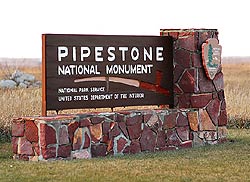
There is no issue in referring to the pipe of most all Indian tribes as being a pivotal sacred object. The pipe provided a meaning and order to the rituals of life. Most famous of all was the T-shaped pipe, or “calumet,” smoked at the signing of peace treaties until it became known by whites as “the peace pipe.”
Ritual pipes were and are stored in sacred bundles and are part of many of the creation stories that describe and explain the origins of many tribes. Pipes are integral parts of ceremony – from making peace to declaring war, guaranteeing the hunt, promoting good trade or practicing medicine.
Virtually all the pipe bowls of all North American Indian tribes are made of the red stone mined at Pipestone, Minnesota. It is believed mining of the area began in the 17th century, and that hunks of the stone or finished pipe bowls were carried across the country by Plains tribes to places like Pecos, New Mexico, where they traded with the Southwestern tribes.
While many legends tell of the origin of the soft, red pipestone fields, one tells of two young warriors came across a beautiful young woman dressed all in white standing in a field of tall grass. One of the young warriors lusted after her and wanted to make her his own. The other young man thought there was something sacred about the young woman and said he would defend her if need be, even against his friend. The beautiful young woman cried tears of blood that turned to stone as they hit the earth before she changed into a white buffalo and disappeared. She was White Buffalo Calf Woman, believed by some to be the mother of all the People.
 The area of pipestone fields has always been in control of some band of the Lakota (Sioux), who managed distribution of the stone to other tribes. The Yankton band had control of the area when Minnesota became a state in 1858, and managed to maintain control of the control. However, as with most agreements made between Indians and white settlers, the agreements weren’t adhered to. With the Yankton Lakotas off on a reservation in South Dakota, they were powerless to stop white settlers from encroaching on the Indian land to quarry the red stone for the construction of buildings in the nearby town of Pipestone.
The area of pipestone fields has always been in control of some band of the Lakota (Sioux), who managed distribution of the stone to other tribes. The Yankton band had control of the area when Minnesota became a state in 1858, and managed to maintain control of the control. However, as with most agreements made between Indians and white settlers, the agreements weren’t adhered to. With the Yankton Lakotas off on a reservation in South Dakota, they were powerless to stop white settlers from encroaching on the Indian land to quarry the red stone for the construction of buildings in the nearby town of Pipestone.
In 1928, fearing the resource would be used up by whites, the Yankton agreed to cede their claim on the land to the federal government. It took another nine years for the Pipestone National Monument to be dedicated, but once it was it became against the law for anyone other than Indians to quarry the area.
A loop of trails lead through the mining areas. Actually mining can be seen during the summer and fall, when water table levels are lowest and the mining is easiest. In the visitor center Native pipemakers give demonstrations of the ages-old techniques and educational information is available for viewing. Pipes and other pipestone carvings are for sale also.
Pipestone National Monument is open daily from 8 a.m. until 5 p.m. It is located in the southwest corner of Minnesota, off Interstate 90 on Highway 75 north of the town of Pipestone.
Pipestone National Monument – 507.825.5463.





